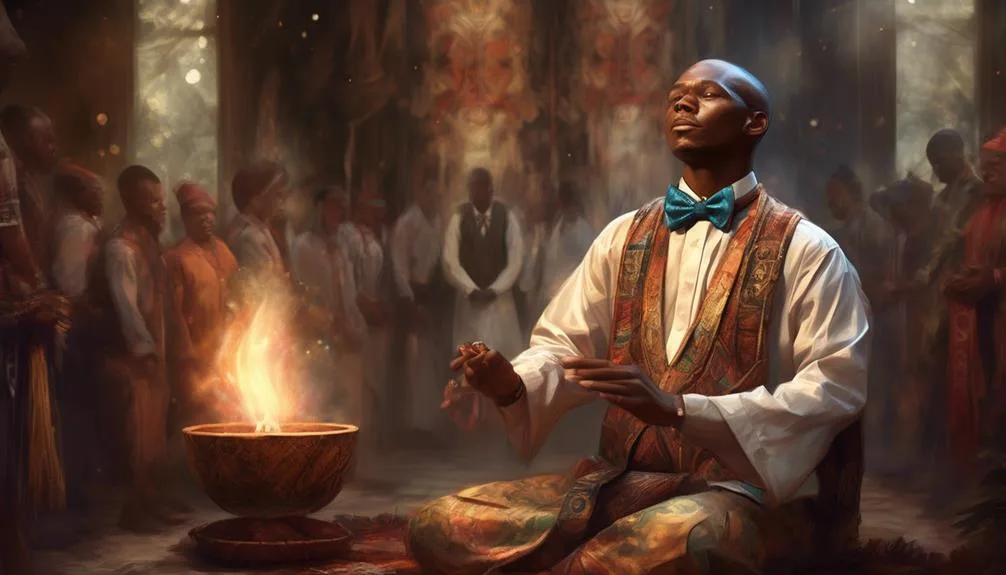Wearing a bow tie is more than just a fashion statement. It has deep spiritual meanings that have been recognized for centuries.
The bow tie symbolizes elegance, grace, and unity in various cultures and traditions. It holds a significant place in rituals and ceremonies throughout history.
Discover the rich symbolism behind this timeless accessory and the profound impact it has had on spiritual practices.
Key Takeaways
- The bow tie has a rich historical and cultural significance dating back to the 17th century, symbolizing nobility and paying homage to tradition.
- The bow tie holds spiritual meaning, representing a connection to something greater and a commitment to spiritual growth and connection.
- The bow tie promotes unity in diversity and signifies shared respect for diversity and inclusion, serving as a unifying force and statement about interconnectedness.
- The bow tie adds formality and elegance to attire, conveying respect for the occasion and others, and can elevate simple outfits to a polished look. Additionally, it is a versatile accessory suitable for various events.
Elegance and Grace

Embracing a sense of elegance and grace, wearing a bow tie adds a touch of sophistication to your attire. It's a fashion statement that speaks volumes about your personal expression.
The bow tie has a historical significance and cultural influence that transcends time and place. Dating back to the 17th century, Croatian mercenaries used scarves to hold together the collars of their shirts, which caught the attention of the upper class, eventually becoming a symbol of nobility and status.
Today, it continues to exude a sense of refinement and style, making it a timeless accessory. By choosing to wear a bow tie, you not only make a fashion statement but also pay homage to its rich historical and cultural roots, adding a touch of elegance and grace to your overall look.
Symbol of Unity
By choosing to wear a bow tie, you embody a symbol of unity that transcends cultural and historical boundaries, bringing people together through its timeless appeal.
The bow tie represents unity in diversity, symbolizing the coming together of different backgrounds, beliefs, and traditions. Its cultural significance lies in its ability to be worn by individuals from various walks of life, signifying a shared respect for diversity and inclusion.
The bow tie serves as a unifying force, promoting the idea that despite differences, we're all interconnected and can coexist harmoniously. When you don a bow tie, you not only express your personal style but also embrace the notion of unity amidst diversity, making a powerful statement about the importance of togetherness and understanding.
- Unity in diversity
- Cultural significance
Spiritual Adornment

When adorning a bow tie, you infuse your attire with a spiritual significance that transcends mere fashion. It's not just about looking good; it's about embodying spiritual empowerment and divine expression.
The act of adorning yourself with a bow tie holds a deep spiritual meaning, symbolizing a connection to something greater than yourself. The bow tie becomes more than just a piece of fabric; it becomes a symbol of your commitment to spiritual growth and connection.
It serves as a reminder to express your inner divinity and radiate spiritual empowerment in all that you do. By embracing this form of spiritual adornment, you honor the sacredness within and project it outward, enriching your presence with a profound sense of purpose and grace.
Representation of Formality
The bow tie represents formality and sophistication, adding a touch of elegance to your attire. It's a symbol of timeless style and sets you apart in a crowd, exuding confidence and refinement.
When you choose to wear a bow tie, you're making a fashion statement that conveys a sense of respect for the occasion and those around you. In the realm of formal attire, the bow tie holds a special place, signifying attention to detail and a keen eye for sartorial finesse.
It can elevate a simple outfit to a more polished and distinguished look, making it a versatile accessory for various events. Embracing the bow tie as part of your wardrobe showcases your appreciation for tradition and your understanding of the power of style.
- Symbol of respect for the occasion
- Conveys confidence and refinement
- Elevates a simple outfit to a polished and distinguished look
Connection to Rituals

With its intricate knots and precise placement, the bow tie holds significance in various rituals and ceremonial settings, symbolizing reverence and attention to tradition.
The bow tie carries symbolic significance in cultural traditions, often worn during important ceremonies to denote respect and adherence to spiritual customs. In ritualistic practices, the act of donning a bow tie is infused with spiritual symbolism, signifying a connection to the divine and an acknowledgment of the sacred nature of the event.
Whether it's a religious rite, a formal gathering, or a cultural celebration, the bow tie serves as a tangible expression of one's participation in the solemnity and sanctity of the occasion. Its presence in these rituals underscores the enduring importance of tradition and the embodiment of cultural heritage, making it a revered emblem of ceremonial observance.
Significance in Sacred Ceremonies
Incorporating the bow tie into sacred ceremonies embodies a deep reverence for tradition and cultural heritage, serving as a tangible expression of one's participation in the solemnity and sanctity of these revered events.
The significance of the bow tie in sacred ceremonies lies in its role as sacred attire, symbolizing the following:
- Connection to Ancestral Legacy: Wearing a bow tie in sacred ceremonies honors the ancestral legacy and upholds the customs and values passed down through generations.
- Spiritual Commitment: The act of donning a bow tie signifies a deep spiritual commitment and respect for the sacredness of the ceremony, reflecting an individual's devotion and reverence.
- Harmony and Unity: The bow tie, as a part of sacred attire, signifies harmony and unity within the community, highlighting the collective participation in the ceremonial symbolism.

